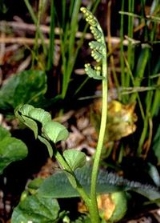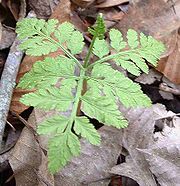
Moonwort
Encyclopedia
Moonworts are fern
s, seedless vascular plant
s, of the genus Botrychium, sensu stricto. They are small, with fleshy root
s, and reproduce by spore
s shed into the air. One part of the leaf, the trophophore, is sterile and fernlike; the other, the sporophore, is fertile and carries the clusters of sporangia or spore cases. Some species only occasionally emerge above ground and gain most of their nourishment from an association with mycorrhizal fungi
. They are unusual among tracheophytes ("higher plants") in that at least some species produce the sugar
trehalose
.
The circumscription of Botrychium is disputed between different authors; some botanists include the genera Botrypus and Sceptridium
within Botrychium, while others treat them as distinct. The latter treatment is provisionally followed here.

Juvenile and dormant sporophytes can also be hidden in the soil for long periods of time. Mature sporophytes do not necessarily produce a leaf annually; they can remain viable underground for up to 10 years without putting up a photosynthetic component. This feat is made possible by their dependence on symbiotic partnership with AM fungi of the genus Glomus, which supply most fixed carbon for growth and reproduction.
This mycorrhizal dependence has also made lab cultivation of moonworts difficult. Thus far, only germination of the gametophyte has been successful.
Fern
A fern is any one of a group of about 12,000 species of plants belonging to the botanical group known as Pteridophyta. Unlike mosses, they have xylem and phloem . They have stems, leaves, and roots like other vascular plants...
s, seedless vascular plant
Vascular plant
Vascular plants are those plants that have lignified tissues for conducting water, minerals, and photosynthetic products through the plant. Vascular plants include the clubmosses, Equisetum, ferns, gymnosperms and angiosperms...
s, of the genus Botrychium, sensu stricto. They are small, with fleshy root
Root
In vascular plants, the root is the organ of a plant that typically lies below the surface of the soil. This is not always the case, however, since a root can also be aerial or aerating . Furthermore, a stem normally occurring below ground is not exceptional either...
s, and reproduce by spore
Spore
In biology, a spore is a reproductive structure that is adapted for dispersal and surviving for extended periods of time in unfavorable conditions. Spores form part of the life cycles of many bacteria, plants, algae, fungi and some protozoa. According to scientist Dr...
s shed into the air. One part of the leaf, the trophophore, is sterile and fernlike; the other, the sporophore, is fertile and carries the clusters of sporangia or spore cases. Some species only occasionally emerge above ground and gain most of their nourishment from an association with mycorrhizal fungi
Fungus
A fungus is a member of a large group of eukaryotic organisms that includes microorganisms such as yeasts and molds , as well as the more familiar mushrooms. These organisms are classified as a kingdom, Fungi, which is separate from plants, animals, and bacteria...
. They are unusual among tracheophytes ("higher plants") in that at least some species produce the sugar
Sugar
Sugar is a class of edible crystalline carbohydrates, mainly sucrose, lactose, and fructose, characterized by a sweet flavor.Sucrose in its refined form primarily comes from sugar cane and sugar beet...
trehalose
Trehalose
Trehalose, also known as mycose or tremalose, is a natural alpha-linked disaccharide formed by an α,α-1,1-glucoside bond between two α-glucose units. In 1832, H.A.L. Wiggers discovered trehalose in an ergot of rye, and in 1859 Marcellin Berthelot isolated it from trehala manna, a substance made...
.
The circumscription of Botrychium is disputed between different authors; some botanists include the genera Botrypus and Sceptridium
Sceptridium
Sceptridium is a genus of seedless vascular plants, closely allied to the genus Botrychium and also closely related to the genus Botrypus . They are commonly called the grape-ferns.These plants are small with fleshy roots, and reproduce by spores shed into the air...
within Botrychium, while others treat them as distinct. The latter treatment is provisionally followed here.
Selected species

- Botrychium acuminatum – pointed moonwort
- Botrychium ascendensBotrychium ascendensBotrychium ascendens is a species of fern known by the common names triangle-lobe moonwort and upswept moonwort. It is native to North America from British Columbia to northern California as well as parts of eastern Canada. It lives in different habitat types, including grassy riverside areas...
W.H.Wagner – upswept moonwort, triangle-lobed moonwort, upward-lobed moonwort - Botrychium australe
- Botrychium borealeBotrychium borealeBotrychium boreale, commonly called Northern Moonwort, is a species of fern. It is short, single leaved rhizome that stands upright....
– northern moonwort - Botrychium campestre – prairie moonwort, prairie dunewort
- Botrychium crenulatumBotrychium crenulatumBotrychium crenulatum is a species of fern known by the common names scalloped moonwort and dainty moonwort. It is native to North America from British Columbia to California to Wyoming, where it is uncommon throughout most of its range, appearing incidentally at scattered spots on wet meadows in...
W.H.Wagner – crenulate moonwort - Botrychium dissectum
- Botrychium gallicomontanum
- Botrychium hesperium – western moonwort
- Botrychium lanceolatum – lance-leaved grapefern, triangle moonwort, triangle grapefern
- Botrychium lineare – narrow-leaved grapefern
- Botrychium lunariaBotrychium lunariaBotrychium lunaria is a species of fern known by the common name common moonwort. It is the most widely distributed moonwort, growing throughout the Northern Hemisphere across Eurasia and from Alaska to Greenland, as well as parts of the Southern Hemisphere including South America and Australia...
(L.Carolus LinnaeusCarl Linnaeus , also known after his ennoblement as , was a Swedish botanist, physician, and zoologist, who laid the foundations for the modern scheme of binomial nomenclature. He is known as the father of modern taxonomy, and is also considered one of the fathers of modern ecology...
) Sw.Olof SwartzOlof Peter Swartz was a Swedish botanist and taxonomist. He is best known for his taxonomic work and studies into pteridophytes...
– common moonwort, grapefern moonwort - Botrychium lunarioides. – winter grapefern
- Botrychium matricariifoliumBotrychium matricariifoliumBotrychium matricariifolium is a common species of fern known by the common names chamomile grape-fern, daisyleaf grape-fern, and matricary grape-fern. It is native to Europe and parts of eastern North America, including eastern Canada and the United States.This fleshy fern grows up to 30...
– daisy-leaved moonwort, matricary grapefern, matricary moonwort, chamomile grapefern - Botrychium minganenseBotrychium minganenseBotrychium minganense is a species of fern known by the common name Mingan moonwort. It is native to North America from Alaska and northern Canada to Arizona, where it is uncommon throughout most of its range, appearing at scattered spots in coniferous forests and marshy areas such as swamps...
VictorinMarie-VictorinBrother Marie-Victorin was a De La Salle Christian Brother and botanist in Quebec, Canada, best known as the father of the Jardin botanique de Montréal....
– mingan's moonwort - Botrychium montanumBotrychium montanumBotrychium montanum is a species of fern known by the common names western goblin and mountain moonwort. It is native to western North America from British Columbia to northern California to Montana, where it grows in the dark understory of coniferous forests and other moist wooded areas...
W.H.WagnerWarren H. WagnerWarren H. Wagner Jr. , known as Herb Wagner, from his middle name, "Herbert," was an eminent American botanist who lived in Michigan...
– mountain moonwort - Botrychium mormo – little goblin moonwort
- Botrychium multifidumBotrychium multifidumSceptridium multifidum is a species of fern in the Moonwort Family, known by the common names leathery grapefern and leathery moonwort. It is native to Europe, Asia, and North America, where it is widespread and grows in moist areas in many habitat types. This is a fleshy, leathery plant growing...
- Botrychium paradoxumBotrychium paradoxumBotrychium paradoxum is a species of fern known by the common name peculiar moonwort. It is native to North America, where there are scattered occurrences in Alberta, British Columbia, Saskatchewan, Montana, Oregon, Utah, Washington, and Wyoming....
– peculiar moonwort - Botrychium pedunculosum – stalked moonwort
- Botrychium pinnatumBotrychium pinnatumBotrychium pinnatum is a species of fern known by the common name northwestern moonwort. It is native to North America from Alaska to northern Canada and Greenland to California and Arizona, where it is generally scattered and uncommon, growing in coniferous forests and grassy meadows...
H. St.JohnHarold St. JohnHarold St. John was a professor of botany at the University of Hawaii at Mānoa from 1929 to 1958. A prolific specialist in field botany and systematics, he is credited with discovering about 500 new species of Pandanus, along with many other species, especially in the Pacific Islands.Born in...
– northern moonwort - Botrychium pseudopinnatum – false northwestern moonwort, false daisy-leaved grapefern
- Botrychium simplex – little grapefern, least moonwort, least grapefern
- Botrychium socorrense
- Botrychium spathulatum – spatulate moonwort, Spoon-leaved moonwort
- Botrychium ternatum
- Botrychium tunux
- Botrychium × watertonense
- Botrychium yaaxudakeit
Conservation
Moonworts can be found in many environments, including prairies, forests, and mountains. While some Botrychium species are quite rare, conservation efforts can be difficult. Determining the rarity of a species is complicated by the plants’ small leaves, which stand only 2-10 centimeters above the soil. Even more of a challenge in obtaining an accurate population count is the genus’s largely subterranean life cycle. The vast majority of any one population of moonworts actually exists below ground in banks consisting of several types of propagules. One type of propagule is the ungerminated spores, which must percolate through the soil beyond the reach of light in order to germinate. This presumably increases the probability that the spore will be in range of a mycorrhizal symbiont before it produces the tiny, roughly heart-shaped gametophyte, which also exists entirely below ground. Finally, some species produce gemmae, a form of asexual propagation achieved by budding of the root.Juvenile and dormant sporophytes can also be hidden in the soil for long periods of time. Mature sporophytes do not necessarily produce a leaf annually; they can remain viable underground for up to 10 years without putting up a photosynthetic component. This feat is made possible by their dependence on symbiotic partnership with AM fungi of the genus Glomus, which supply most fixed carbon for growth and reproduction.
This mycorrhizal dependence has also made lab cultivation of moonworts difficult. Thus far, only germination of the gametophyte has been successful.

